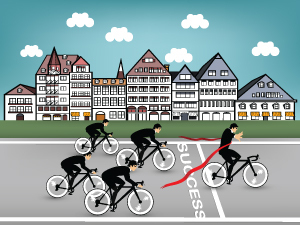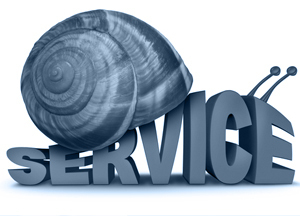Andy Paul's Blog, page 101
March 24, 2015
Does Your Sales Hiring Compare To How The NFL Evaluates Players?
 The NFL draft is fast approaching. Professional football teams have invested tremendous sums of time and money in scouting, testing, interviewing, assessing and grading elite college players in an effort to hire those who have the skills and potential to help their teams succeed on the field and win championships. How much time and money do you invest in your sales hiring process?
The NFL draft is fast approaching. Professional football teams have invested tremendous sums of time and money in scouting, testing, interviewing, assessing and grading elite college players in an effort to hire those who have the skills and potential to help their teams succeed on the field and win championships. How much time and money do you invest in your sales hiring process?
Pro teams amass a mountain of data about the past performance and the future potential of each of the young men that they select in their annual player draft, and yet, when that day arrives, the best that these experienced evaluators of talent and potential can say is that they are making what could best be called “educated guesses” about the players that they select. Only 30% of the first round picks in the draft are ever selected to the Pro Bowl team even once in their career (which is the all-star event that I’ll compare to making President’s Club for a salesperson.)
Does that sound familiar? How many of your top sales hires have become superstars at your company? 30%? Or fewer?
If pro football’s hard-nosed, experienced evaluators of potential talent are so often proven wrong, what does that say about your hiring process?
Let’s compare how the pros evaluate potential draft picks to your hiring process.
A) Teams employ scouts (or scouting services) that spend their autumn weekends attending a lot of college football games in an effort to identify players who they think have the potential to play at the professional level. and succeed in the NFL.
B) Are you, or members of your management team, regularly networking with potential sales hires? Are you building a list of salespeople that you’ve met, or competed against, that you think would be a good fit for particular needs you have on your sales team and could succeed in your sales environment?
A) Teams employ evaluators to watch video of virtually every play a player was involved in during their college career in order to assess their skills and potential to succeed at the next level.
B) Do you ever see potential sales candidates “in action?” before you make the hiring decision?
A) At the Combine (which is like a big job fair for the draft-eligible college players that the various pro teams agreed had the highest potential to succeed in their league) team officials subject the players to a blizzard of personality testing, aptitude testing and extensive interviews.
B) Are you utilizing off the shelf tools like sales assessment tests to help you gauge the suitability of a candidate for your position? These assessments provide a valuable data point to incorporate into your decision making about a sales candidate.
A) A player’s job specific knowledge is also tested. In interviews with a player, coaches will map out scenarios about certain game situations and ask the player to describe in detail what their responsibilities would be in those situations, how they would react and what actions they would take.
B) Are you testing for the specific product and industry knowledge that a salesperson must possess in order to succeed at your company?
A) The players are physically tested at the Combine. They are run through a series of drills to demonstrate how fast, quick, agile, explosive and just plain strong they are. Players also showcase their talents in private workouts for teams. In these workouts the players are put through drills that require them to demonstrate mastery of the skills that are specific to the role that they could play for that team.
B) Are you testing the sales skills of candidates before you make a hiring decision? For instance, if they need to make cold calls or formal sales presentations, are you testing their skills in these areas as part of your interview and evaluation process?
A) The teams and the NFL conduct extensive reference and background checks on the players before they make a draft decision.
B) Are you just going through the motions with your reference checks? And, like most managers, are you conducting reference checks only after you have already decided to hire a specific individual?
Only after this exhaustive process of collecting and analyzing all of this data do teams begin the process of deciding who they want to hire for their team via the draft.
How Does Your Process Stack Up To The NFL’s?
If pro football’s sophisticated and extensive player evaluation process yields unpredictable results, in terms of the productivity of the new hire once they are on the job, what does it say about your sales hiring process?
Are you using predictive tools, such as personality and aptitude testing, to assess the potential of sales candidates?
Are you formally testing candidates for their product knowledge and industry expertise?
Are you thoroughly testing candidates for the job skills that you believe are required to succeed in a sales position at your company?
Do you test their written communications skills?
Do you require them to make a sales presentation to you?
Do you perform role-playing about certain sales situations?
Are you conducting reference checks early in the interview process before you make a decision about the candidate?
Most importantly, are you measuring the success of your sales hiring process? And refining it to make it more effective?
So, how does your sales hiring process compare to the pros?
NFL is a registered trademark of the National Football League.
The post Does Your Sales Hiring Compare To How The NFL Evaluates Players? appeared first on Andy Paul | Strategies to Power Growth.

March 23, 2015
How To Build Trust With The “Ask. Don’t Tell.” Formula
 Here’s a powerful, but simple, sales technique to help ensure that you keep the focus on the customer in your sales interactions. It is an effective method to build trust with the customer and to demonstrate that your primary concern is understanding their requirements and learning what you need to do to deliver value to them. This works equally well whether you’re meeting in person with a prospect, meeting virtually or talking on the phone.
Here’s a powerful, but simple, sales technique to help ensure that you keep the focus on the customer in your sales interactions. It is an effective method to build trust with the customer and to demonstrate that your primary concern is understanding their requirements and learning what you need to do to deliver value to them. This works equally well whether you’re meeting in person with a prospect, meeting virtually or talking on the phone.
I call this the “Ask. Don’t Tell.” formula. Every time you have an opportunity to tell your prospect something, ask a question instead. Ask. Don’t Tell.
Instead of telling a prospect “We have this great feature xyz…” ask them “If you had the capability to do xyz, how could you put that to use in your business to improve productivity?”
Or, instead of telling a prospect “Our customers average a 20% improvement in performance after the first year using xyz…” ask the question “If you were able to improve productivity by 20% within 12 months how could you use the additional capacity to immediately boost your market share?”
Imagine that you are on a first call with potential prospect. This is an early make or break moment for you in the customer’s buying process. This is the point in time where you can begin to build the foundation of trust and credibility you need to differentiate yourself from the competition.
If you are in a telling mode then everything you say is fundamentally about you. Even if benefit statements accompany all of your factual claims you are still talking about yourself. And the customer senses this. On the other hand, if you ask a question, the focus is on them, the customer. Which method builds trust? Which approach opens the door to developing the credibility you need to become a trusted advisor to the customer?
In order to amplify the impact of your selling, don’t tell the customer the value your product or solution will provide to them. Let them tell you. Don’t tell the customer the entire story. Let them fill in the blanks on their own. Questions give your prospects the license to think about your product or service as a user would. Suddenly they will transition from half-heartedly listening to your pitch to taking a mental test drive of your offering. And, when they have to formulate an answer to your question, they have to articulate the value that they will receive from you. In that process, they start taking some ownership in the solution.
View the “Ask. Don’t Tell.” formula from the perspective that an effective salesperson also has to be a bit of a therapist. Think about the similarities. A person consults a therapist when they have a problem that they can’t solve on their own. They need outside help. They seek out a therapist because they need an objective third party to help them understand their problem and provide a path to the solution. An effective therapist doesn’t provide you with the answer to your problem. Instead, they ask insightful questions that enable you to identify the problem you need to solve and to arrive at a solution. The goal is for you to figure it out, led by the questions the therapist asked.
If you want to help your customer solve their problem, don’t tell them the answer. Ask them the question.
The post How To Build Trust With The “Ask. Don’t Tell.” Formula appeared first on Andy Paul | Strategies to Power Growth.

March 20, 2015
Sales Tip Video: A Simple Strategy to Simplify and Accelerate Your Sales
Is your sales process aligned with your prospects’ buying process?
Customers possess what I call a universal buying objective—the need to quickly and effectively compare and evaluate solutions from potential suppliers to make an informed decision. The time your customers spend to gather the necessary information from you and your competitors to make a purchase decision is valuable time taken away from other important responsibilities.
Click below to watch this video for a simple but effective step you can take to align your sales process to your customers’ buying objectives.
The post Sales Tip Video: A Simple Strategy to Simplify and Accelerate Your Sales appeared first on Andy Paul | Strategies to Power Growth.

March 19, 2015
The Aggregation of Marginal Gains: How A 1% Improvement Will Lead to Winning More Orders.
 Professional bicycle racing is a highly technical sport. The technology involved in the design and construction of the bicycles, as well as the advanced technology employed to train and measure the fitness of the riders themselves, have evolved to the point where there are no sizable breakthroughs occurring that will enable one team to enjoy a sizable, sustained competitive advantage over its competitors.
Professional bicycle racing is a highly technical sport. The technology involved in the design and construction of the bicycles, as well as the advanced technology employed to train and measure the fitness of the riders themselves, have evolved to the point where there are no sizable breakthroughs occurring that will enable one team to enjoy a sizable, sustained competitive advantage over its competitors.
This same competitive dynamic affects most sellers today. The pace of technological innovation has made it extremely difficult for any one company to establish and maintain any degree of meaningful product or service differentiation. Increasingly, when customers survey vendors to evaluate new products and services for purchase they see a field of competitors that virtually all look alike.
The Aggregation of Marginal Gains
Dave Brailsford, manager of the British-based Sky bicycle racing team, aspired to have his riders win the Tour de France. In 2010 he decided that the path to victory would be based on his theory of the “aggregation of marginal gains.” What he meant was that since there were no secrets or revolutionary gains to be made in the sport, his focus was going to be on making continuous small one-percent (1%) improvements in every element of his team’s process for preparing its riders, bicycles and strategies and executing its race plan in order to gain even the slightest advantage over its competitors.
Brailsford believed that if his riders continually focused on improving every aspect of their daily routine by 1% then they would develop a small, but sustainable, advantage over their competitors. They applied this level of discipline to every aspect of their daily routines, both large and small, including their fitness, their aerodynamic positioning on their bike, their recovery and sleep habits, their personal hygiene to prevent illness and lost training time and even to the clothing and helmets they wore during races. And, it paid off. Sky’s lead riders, Bradley Wiggins and Chris Froome, won the Tour de France in 2012 and 2013 respectively.
What’s Your Margin of Victory?
Let me ask you. How much did you win your last order by? Were you 5% better than the competition? 10%? 25%? Do you even know?
In the Tour de France, which is contested over 21 days and during which the riders race over 3000 miles, the average margin of victory that separates the winner and the 2nd place finisher is almost always less than one-tenth of 1% of the total elapsed time of the winner. (In the 2014 Tour de France, the winning rider, Vincenzo Nabali of Italy, crossed the finish line more than 7 minutes ahead a the second place finish, a modern record for the winner’s margin of victory. However, against Nabali’s winning time of 89 hours and 59 minutes, that represents a margin of victory of slightly more than one-tenth of 1%.)
As I describe in my most recent book, Amp Up Your Sales, sellers need only be 1% better than their competition in order to win an order from a prospect. Maybe even less than 1%. In crowded, competitive markets where buyers struggle to draw distinctions between sellers, they look beyond the product or service they are evaluating for tiebreakers that provide value to them.
Marginal Gains for Sellers that Add Value
Here just a few examples of some marginal gains that you can aggregate into your sales process to gain a 1% advantage:
1. Promptly Follow-up Sales Leads:
According to research from Insidesales.com, a very large fraction of inbound sales leads, reportedly up to 73%, are never followed up. Many buyers have given up on the idea that a salesperson will ever respond to an inquiry. But the salesperson who follows up in a responsive fashion will be perceived by the buyer as providing value and will create a marginal gain that separates him or her from their competition.
2. Accelerate Your Responsiveness:
It is not enough to just make the effort to respond. Being responsive in sales means that are quickly providing the information that your buyers need to move forward in their decision-making process. You have to continually tweak and refine your sales processes in order to find ways to respond faster and with more valuable questions, answers and insights. More often than not it will be the first seller with the answers who wins the deal.
3. Maximize The Value You Deliver on Every Sales Touch:
The standard for every sales touch, no matter how big or small, is that it must deliver something of value to the prospect that helps them move at least one step closer to making a decision. Your prospects invest their time in you. If a prospect becomes trained to expect value from you in each and every sales touch, then that represents a marginal gain that provides a real competitive advantage to you.
4. Invest Your Time to Acquire Specialized Knowledge:
Increasingly buyers want to deal with salespeople who have the specialized product knowledge, industry expertise, business insights and acumen to help them develop a better solution to the problem they are trying to solve. Become the salesperson who invests 1% of his or her time (just 24 minutes per week every week) to develop their knowledge, skills and expertise. Read books and blogs, attend webinars and conferences and spend time with your company’s technical experts. It takes just 1% of your time to become a sales resource that your prospects will recognize as a source of value that is worth the investment of their time. That will set you apart from nearly all of your competitors.
In the end, it is all about having the discipline and the commitment to take the necessary steps to continually improve all aspects of your selling. What will it take to make them 1% better? Because, in the end, you only need to be 1% better than the competition to win your customers’ business.
The post The Aggregation of Marginal Gains: How A 1% Improvement Will Lead to Winning More Orders. appeared first on Andy Paul | Strategies to Power Growth.

March 18, 2015
How to Accelerate Sales By Avoiding Empty Sales Touches
 Sellers and buyers alike want to accelerate the sales and buying processes. Both parties can realize measurable gains in productivity if these processes were shorter. So, what’s holding them back?
Sellers and buyers alike want to accelerate the sales and buying processes. Both parties can realize measurable gains in productivity if these processes were shorter. So, what’s holding them back?
On average, how many meaningful, substantive sales touches do you have with a prospect in your typical sales cycle?
First, subtract all the meaningless one-sided “touching base” emails and “checking in” voice mails that you send to a prospects and then count how many meaningful sales touches you have in your average sales process where you actually interact with and deliver value to your prospect.
The number will vary by the nature of the product and service being sold. But in general, the answer is “not many.” And that number is shrinking as customers put more pressure on sellers to help them navigate their buying process is a shorter period of time and with fewer sales touches.
If you waste just one of those sales interactions without delivering meaningful value to your buyer, what percentage of your sales cycle will you just have wasted?
It is absolutely essential to avoid empty sales touches, which are sales interactions that consume your buyers’ time without giving them anything of value in return. Waste your buyers’ time and it will make them reluctant to invest more time in you. If that happens, you’ll be on the outside looking in with your nose pressed against the glass as the buyer moves forward with your competitor.
Two Important Value Questions
Here’s a simple way to accelerate sales by avoiding empty sales touches. Answer these two questions before each and every interaction with a prospect:
1. “What value I can deliver today that will help move the customer at least one step closer to make a purchase decision? (Another way to frame the question is to ask ‘What information does the buyer need from me today to move at least one step closer to making a purchase decision?’)
2. “What’s the very next action that I want the customer to take as a result of receiving this value?”
If the answer to either question is “I don’t know,” then don’t do anything with that prospect until you do. Each time you interact with a prospect they invest some of their limited time in you and they expect to receive something of value in return. If you train a prospect through empty sales touches to expect not to receive value from you, then you can expect not to receive any more of their time in order to sell to them.
You’re better off sitting on your hands than calling the customer without a plan to deliver value.
Are You Prepared To Deliver Value?
Let’s look at how this works in practice. Let’s assume that your typical sales cycle has five actual interactive touches with your buyer. Last week you met a potential prospect at a business event and scheduled a time to meet them at their office to follow-up on their interest in your services. You showed up at the meeting two days later but you hadn’t adequately prepared in advance. You hadn’t spent enough time learning about the prospect, their products, their industry, the people you were going to meet and the challenges they faced in their business. In short, you weren’t ready to ask the probing questions that would get to the heart of the prospect’s requirements and, as a result, you missed out on uncovering their key pain points.
The prospect exited the meeting without learning substantially more about your services than they knew going in. They had doubts about working with you and your company because you didn’t deliver anything of value in the meeting that would help them move closer to a decision. As a result the meeting didn’t produce an outcome that was satisfactory to the buyer or to you. The customer felt that you unnecessarily wasted their time. And, you didn’t secure a commitment from the buyer to move forward in their process.
This is the point in the sales process where salespeople often trip up. That empty sales call just wasted one of your five meaningful sales touches. 20% of the opportunities you have to deliver value to a buyer just disappeared for good. Suddenly, you’re behind the curve with the prospect. Not only did you fail to deliver value you didn’t provide the prospect with a compelling reason to move their buying process with you to the next step. When this happens, it’s extremely difficult to make up lost ground and in all likelihood you will be fighting for second place. And, as we know well, there are no medals for coming in second in sales.
Remember: start by answering this simple question before every sales touch: Am I going to deliver value to the prospect in this interaction that will move them at least one step closer to making their decision? Don’t waste the prospect’s time, or your time, until the answer to that question is yes.
The post How to Accelerate Sales By Avoiding Empty Sales Touches appeared first on Andy Paul | Strategies to Power Growth.

March 17, 2015
Two Tips to Eliminate Momentum Killers in Your Deals
 Imagine for a second that you’re the customer.
Imagine for a second that you’re the customer.
You’re searching for the final key bits of information on a product or service that you want to buy. You’ve invested a fair amount of your time in the buying process and you’re already starting to anticipate how it will be to use the product.
You’ve only got one or two more key questions about the product before you make your decision. You ask the salesperson for answers and get the dreaded “Let me get back to you” response.
It’s probably not the answer you were hoping for, right? I call this a “get-back” and it can bring your sales efforts to a crushing halt.
Get rid of your “get-backs.”
Get-backs impede your ability to build trust and confidence with the customer. If you continually have to ‘get back’ to the customer to provide the information they need right now, then the prospect has to invest more of their limited time to reach a decision point with you than with your competitors. Which means the ROI buyers earn on the time they’re investing with you is smaller than with your competitors. Strike one.
Get-backs inject unnecessary delay into your customer’s buying process. Taking an extra day, or even an extra hour, to provide information to your prospects that they need right now increases the chances that a competitor jumps in and demonstrates the complete responsiveness needed to win the business. Strike two.
Remember, every time you hit the customer with a ‘get-back,’ you’re disengaging from their buying process. This pause, this momentum crusher, creates an incentive for the prospect to consider alternative solutions that keep them on the path to making a decision. Strike three. You’re out.
So, what can you do to eliminate ‘get-backs?’ Here are two quick tips to get you on the right track:
1. Know your product better than your customer does. This is not a very high bar to set for yourself. The bottom line is that you must know more about how your product functions and have a better understanding of how it can integrate into your prospects’ current operations (or processes) than they do.
Invest your own time to learn your product or service offering inside and out. Create a personal learning plan and block out at least one hour per week in your calendar to spend time with the product experts in your company. And, just when you think you’ve learned enough, double down and invest even more time to learn the detailed ins and outs of your offering that others won’t. This detailed and nuanced knowledge is an instant credibility builder with a prospect.
2. Thoroughly understand how your existing customers are using your products in their businesses. Spend time with a current customer and interview them about how they are using your product or service. Dig beneath the surface to develop a deep understanding of the value that they are receiving from their use of your product. How does it exceed their expectations? What are the top line and bottom line improvements they are experiencing with your problem? What are the financial returns they are earning from their investment in your products or services? Lastly, ask them to share with you one piece of advice that they’d give to one of your current prospects to help them with their evaluation of your value proposition.
At the end of the day, selling is really just a service that you provide to your prospects. And, when has it ever been good service to make a busy prospect wait for you to “get back” to them?
The post Two Tips to Eliminate Momentum Killers in Your Deals appeared first on Andy Paul | Strategies to Power Growth.

March 9, 2015
Great tips for building and scaling a sales team: Interview with Mark Roberge
I had the chance recently to talk with Mark Roberge about his experiences building the sales team at HubSpot that drove its rapid growth from start-up to $100 million in revenues.
 Mark, who is currently the Chief Revenue Officer for HubSpot’s Sales Division, has also just published a book about that experience titled “The Sales Acceleration Formula: Using Data, Technology and Inbound Selling To Go From $0 to $100M.” It’s a good read. Check it out.
Mark, who is currently the Chief Revenue Officer for HubSpot’s Sales Division, has also just published a book about that experience titled “The Sales Acceleration Formula: Using Data, Technology and Inbound Selling To Go From $0 to $100M.” It’s a good read. Check it out.
AP: What is the biggest driver of sales success for an organization?
MR: Hiring. Hands down.
AP: What do you look for in a sales hire?
MR: There were five criteria that stood out for us over the years. They were coach-ability, curiosity, work ethic, prior success, and intelligence. I find these criteria to be strong influencers for the ideal salesperson at many early stage technology companies.
AP: How do you screen for “coach-ability”?
MR: I devise a role play where I am a prospective customer for HubSpot and the candidate is the HubSpot salesperson. We role play for 5 to 10 minutes. After completing the role play, I ask the candidate to self-assess. I like people that are introspective. I then provide them with one area where they did well and one area where they can improve. I watch how they respond as I provide feedback. Are they glassy eyed and defensive? Or are they engaged and asking good clarifying questions? Finally, I ask them to re-do the role play and observe how they apply the coaching.
AP: In a hot market for top sales talent, where did you find the best candidates?
MR: Finding great sales people is the biggest driver of sales success. Great sales people never have to pull together a resume. Great salespeople receive phone calls from their former managers every quarter asking if they are happy and inviting them to work for them again. Organization must find a way to engage and entice these top performers before they are in the job market to consider joining their company. In this case, a passive recruiting strategy is critical.
AP: What is a passive recruiting strategy?
MR: There are two passive recruiting techniques that we used quite successfully at HubSpot.
The first I call the “forced referral”. Most organizations attempt to trigger referrals from existing employees by posting a referral bonus. In my experience, this approach fails to generate the continual stream of qualified, passive candidates necessary to scale.
Instead, I scheduled a 15-minute meeting with a new employee about 2 months after they joined the company. The evening before the meeting, I browsed through their 300 or so LinkedIn connections and made a list of potential candidates located in our area that looked like a good fit for our company.
I’d bring the list to the meeting with the new employee. You’lll be surprised how often your new employees simply forgot about highly qualified candidates in their network. I’d review each candidate on the list and have the new employee tell me whether the candidate was worth pursuing and whether they’d provide a warm introduction to instigate a discussion.
The second technique simply leveraged the advanced search capability in LinkedIn. We’d search for people with sales or account executive titles; focusing on people in our area. We’d filter for people working at companies that have a large, well-trained sales team.
Rather than using InMail to reach out to these candidates, we’d try to get into their Inbox by guessing their email. For the subject line, we’d type in their current employer and their undergraduate college. For example, if they work at Yahoo and went to Boston College, we’d make the subject of the email “Yahoo / Boston College”. Almost everyone would open that email. Then we’d make the body of the email short, simple, and enticing.
AP: You’re a big believer in using data and technology to build a sales team. Where did you apply these in building your team at HubSpot?
MR: Hiring. Training. Managing. Generating demand. I tried to create predictable, scalable approaches to each of these categories of building sales using data and technology.
With hiring, I quantified the criteria that we thought would correlate with success in our sales context. We scored candidates, measured success, tested the correlation theory, and iterated over the years. We boiled our training down to a predictable set of product exams and sales process certifications that clearly defined expectations and measured the performance of new hires early in their development.
We managed through metrics-driven coaching, a framework used to continually diagnose each salesperson’s funnel deficiencies and customize coaching plans to address these deficiencies. With demand generation, we define a sales and marketing service-level agreement, or SLA, to quantify the deliverable that marketing would deliver to sales and vise versa.
Not every aspect of scaling a sales team can sit on a foundation of data and technology. However, many can and it is the best place to start.
AP: How did you use data to drive sales productivity?
MR: Effective sales coaching drives sales productivity. Developing salespeople through great coaching is the most important role of the sales manager. To improve our coaching I implemented a process I called “metrics-driven sales coaching”. The best coaches diagnosed the one or two skills that would make the biggest difference in a salesperson’s performance and customized a coaching plan to that skill. They used metrics to conduct this diagnosis.
AP: Give me an example of metrics-driven sales coaching.
MR: At the start of each month, as a manager, I reviewed each of the key conversion metrics within a salesperson’s funnel. Let’s assume that the salesperson I was meeting with had an off month. The metrics may have shown that he had a high number of voice mails and emails relative to the rest of the team. However, he only converted a small percentage of this activity into a qualified appointment. Clearly, he was struggling with this stage of the funnel.
My first step would be to try to learn more from the metrics. In this case, did the salesperson generate a lot of voice mails and emails but struggle to get the prospect on the phone? Or did the salesperson get plenty of people on the phone but fail to peak their interest to get to the next stage of the buying journey? The difference here is critical, as my coaching would vary significantly depending on the diagnosis.
// ]]>
The post Great tips for building and scaling a sales team: Interview with Mark Roberge appeared first on Andy Paul | Strategies to Power Growth.

March 6, 2015
Sales Tip Video: Are You Giving Prospects a Clear Choice?
The first line of differentiation between you and your competition is you, the salesperson. Prospects count on you to be a service provider, a source of value in the form of information and insights, that help them quickly and confidently navigate through their buying process. Watch this video to learn a couple tips that you can use today to set you apart from competitors and make you the clear choice for your prospects.
The post Sales Tip Video: Are You Giving Prospects a Clear Choice? appeared first on Andy Paul | Strategies to Power Growth.

March 5, 2015
“What You Do Speaks So Loudly, I Cannot Hear What You Say”
 I use a lot of ink to talk about sales as a service that you provide to your prospects; a service that can differentiate you from your competitors. I teach the importance of follow-up and how to use responsiveness to deliver value to your customers and win more orders in less time.
I use a lot of ink to talk about sales as a service that you provide to your prospects; a service that can differentiate you from your competitors. I teach the importance of follow-up and how to use responsiveness to deliver value to your customers and win more orders in less time.
In fact, being responsive and value-based follow up are such easy things to do. These are activities that are under your direct control. There are no pre-requisites for responsiveness and effective follow-up. Just consistently do these two simple things and your sales will take off.
And, yet, it seems that every day I encounter examples of unresponsive follow-up and unintentionally bad sales service that could easily be avoided.
In my first book, Zero-Time Selling, I described an incident that happened to me a few years ago. A prolonged drought had driven what seemed like several million thirsty ants from my backyard into my kitchen. They were marching in thick black undulating rivers across my white tile floors. My wife, kids and dogs were freaking out. I needed help.
I opened my laptop and searched online for a local exterminator. The first company listed at the very top of Google’s paid search returns claimed to have an organic, technological solution for exterminating pests that was safe for people and pets. Perfect! My dogs would appreciate that, and the ants would hate it. I picked up my phone and entered the number of their 24-hour customer service hotline. I was ready to buy.
The “hotline” offered up a recording that claimed that everyone was busy helping a customer, so it invited me to leave a message for one of their friendly customer service technicians. Then, the exuberant female voice on the recording proudly trumpeted: “It’s our company policy: your phone call will be returned within 24 hours. Guaranteed!”
Wow. Twenty-four hours. They thought that was fast. My thought was, “I have ants all over my house and they want me to wait a day just to get a call?” I called the next pest-control company on the list. A live person answered the phone and set me up with an afternoon appointment for that same day.
That first pest-control company I called, which was a big brand name, had the perfect opportunity to capture my business. But, like a lot of companies, they prized their own convenience over good customer service and tried to turn that into a virtue.
Instead of helping me they communicated three negative messages to me and all other prospective buyers:
1. Your call is not that important to us. In fact, you won’t even speak to a live person when you call.
2. The only guarantee we can offer is that we won’t call you back until tomorrow. What’s the rush? We’ve given ourselves 24 hours to do it.
3. We need to have a company policy in place to force someone to call you back at all.
Many companies fool themselves into believing they are offering great customer service when, in fact, they are advertising and delivering the opposite. Have you fallen into this same trap? You may think you are fooling your customers but to quote the great American writer Ralph Waldo Emerson, “What you do speaks so loudly that I cannot hear what you say.”
Before you start to believe that a 24-hour response time to a customer or prospect is even remotely acceptable (which it isn’t), think about the level of service you deliver from their point of view. What do they need from you to be successful in their jobs and lives with the least investment of their time possible? That is the standard of service you need to provide.
The post “What You Do Speaks So Loudly, I Cannot Hear What You Say” appeared first on Andy Paul | Strategies to Power Growth.

March 3, 2015
Are You Guilty Of Decision Creep?
 Are you a perpetrator of decision creep?
Are you a perpetrator of decision creep?
Decision creep is a self-inflicted injury that occurs when a seller falls into the trap of pushing a purchase decision to higher levels in the prospect’s company than is required. It slows down decision cycles and increases your risk of not winning the order.
The problem starts with the common sales assumption that it is universally desirable to sell to the C-Suite. It isn’t.
Not all products are created equal.
The product or service you sell falls into one of two categories. It is either strategic or tactical for the customer. Strategic products will typically require a broader internal consensus and approval at higher levels. Tactical products don’t. In other words, are you selling mission critical networking infrastructure or paper clips?
I know that all sellers would like to think that their products or services are strategically important to their customers. The fact is, in most cases, they’re simply not.
This doesn’t mean your product or service isn’t important. It’s just not strategic. Sometimes a vendor is just a vendor, not a “partner.” This also doesn’t mean the customer doesn’t value their relationship with your company or that they don’t appreciate the great customer service you provide. But, not every product is strategic and not every product can command the time and attention of the C-Suite.
Strategic vs. Tactical Products
What are strategic products? These are mission-critical purchases or acquisitions that can measurably affect the revenue and/or profitability of a company. In rough terms, any product or service that can demonstrably have a measurable impact on revenue and profitability, or that has a certain level of complexity and a price that is large in relation to the company’s revenues, can be a strategic product.
Tactical products and services are most everything else. These are items that a company can’t necessarily operate or function without, but the price and complexity level of the product or service is low relative to the size of the company. Tactical products and services are relatively commoditized, meaning that the buyers have multiple vendors to choose from and pricing is often one of the primary purchase considerations.
Well over 90% of the purchase decisions a company makes in the course of a business year are for tactical products or services. Think of a typical $50 million revenue company. This is a classic small business but it makes thousands of purchases every year. In very few cases are the actual decisions about which of these thousands of products or services to purchase made at the C-level. (There just isn’t enough time in the day.)
Decision Creep
I worked once with a client’s sales guy, Jim, who always oversold his product. By oversell I don’t mean that he promised it would do things it couldn’t. Rather, he was always pushing to sell his product, a design tool used by engineers, to the C-Suite. The design tool he was selling was a tactical product and, typically, the decision to buy his product was made by the engineer who would use it; sometimes by an engineering manager. But, Jim had taken a sales training class that taught that he always had to sell to the C-Suite and he wasn’t to be dissuaded.
In one case Jim had finally penetrated a large account that previously had purchased almost exclusively from one of his main competitors. In fact, they were ready to buy from him, but on Jim’s insistence, his chief internal advocate set up a meeting with his CEO. When Jim met him, the first words out of the CEO’s mouth were, “Why am I in this meeting? I’m not involved in this decision.” This was followed by “But, since you asked, I do have an opinion…” Which was that they should stick with the incumbent.
Don’t be like Jim and let decision creep come back to bite you.
Determine if your product is strategic or tactical. For tactical products and services, the responsibility for most purchase decisions resides at a lower level in your customers’ organizations than you think. Instead of reaching too high, look for the actual decision maker for your product or service.
Who’s the actual decision maker? Come back here next week for part 2 of this article. I’ll give you some simple tips you can use to find and qualify the actual decision maker for your products.
// ]]>
The post Are You Guilty Of Decision Creep? appeared first on Andy Paul | Strategies to Power Growth.

Andy Paul's Blog
- Andy Paul's profile
- 4 followers





